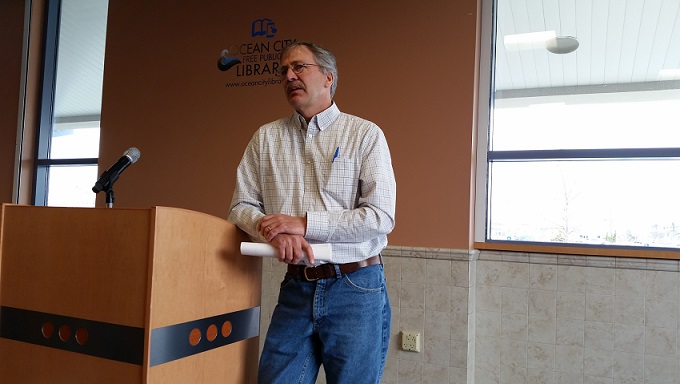By Donald Wittkowski
Over on Bayonne Place, Dot Aitken saw her street transformed into a river by the powerful storm that unleashed the worst tidal flooding since Hurricane Sandy in 2012.
With the fury of the Jan. 22-23 nor’easter still fresh on her mind Aitken was among more than 80 residents who turned out for a public meeting Saturday to hear about the latest project to protect the island community from flooding.
Ocean City plans to spend $17.4 million in 2016 and $34.6 million over the next five years on a series of road and drainage upgrades designed to reduce flooding.
Saturday’s meeting focused on one of the first projects scheduled to get underway, a $1.6 million overhaul of the road and drainage system in the Third Ward between 14th and 16th streets from Bay Avenue to the bay. In addition, the work will extend from 16th Street to West Avenue.

Third Ward Councilman Tony Wilson organized the meeting to outline the benefits of the project and answer questions from concerned homeowners. The large turnout at the Ocean City Free Public Library also included residents from outside the Third Ward, underscoring the seriousness of flooding throughout town.
“When people bring up flooding, it’s a buzzword for something that affects the whole city,” Wilson said.
Work on the Third Ward project is expected to begin as early as March and be completed by Memorial Day, said Roger Rinck, Manager of Engineering and construction for the City’s Engineering Division.
Rinck noted that the project is emblematic of citywide anti-flooding efforts. Streets will be raised with a new layer of paving. Bigger pipes will improve drainage. There will also be new curbs and sidewalks.
Rinck said all of those things will give residents more protection. However, he also stressed that no single project can provide an ironclad guarantee against the type of extreme flooding that was spawned by Hurricane Sandy or last month’s nor’easter.
“If the perfect storm comes, it’s no crapshoot. It’s not going to work,” Rinck warned the residents.
Wilson, though, expressed confidence that the facelift for the Third Ward’s roads and drainage will be a vast improvement over what exists now.
“It’s a great project,” Wilson said. “It will upgrade the infrastructure, beautify the streets and prepare us for the 10-year storm.”
Rinck recalled how there was little flooding on the island years ago. Then flooding became more frequent during a series of powerful storms during the 1980s and 1990s. After a more recent period of calm, severe flooding returned during Sandy and last month’s nor’easter, he added.
“The sad reality is, the sea level is rising,” Rinck said.

Aitken, who has had to deal with repeated flooding at her Bayonne Place home during the three years she has lived there, is convinced the problem is getting progressively worse. One of her neighbors displayed a cellphone photo that showed their part of Bayonne Place was completely underwater during the nor’easter.
“There never used to be flooding up to the bay. Now, it floods up to the bay,” Aitken explained.
Marion Letterie, another resident on Bayonne Place, said the nor’easter filled her garage with water. She was forced to rebuild her home on elevated pilings after Sandy destroyed her first house at the same location.
Letterie is skeptical whether the road and drainage improvements planned between 14th and 16th streets will alleviate the flooding. She fears that old, leaky bulkheads along 16th Street remain a weak spot.
“I’m not hopeful,” Letterie said.
Mayor Jay Gillian, in his weekly message posted on the city’s website, said the improvements planned between 14th and 16th streets include increasing the capacity of drainage pipes and reconfiguring the roads to move flood waters into the storm drainage system.
Following the most recent rounds of flooding, the city has begun clearing out drain tops every day, while street sweepers are removing debris from roads on a daily basis, Gillian said.
The mayor also said he asked the Public Works Department to inspect each one of the city’s check valves, the mechanisms that prevent tidal waters from flowing backwards through the storm drainage system and onto the streets.
The inspection process at more than 40 different locations usually is spread out over the year, but crews made sure each valve was working all within the last week, according to Gillian.
Wilson wrapped-up the meeting reminding his constituents that he is available to discuss this project or any other issues within the Third Ward.






